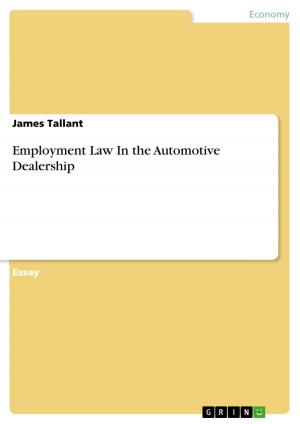A Dead Narrator in Charles Higson's Getting Rid of Mister Kitchen
Fiction & Literature, Literary Theory & Criticism, British| Author: | Andreas Raab | ISBN: | 9783640309368 |
| Publisher: | GRIN Publishing | Publication: | April 9, 2009 |
| Imprint: | GRIN Publishing | Language: | English |
| Author: | Andreas Raab |
| ISBN: | 9783640309368 |
| Publisher: | GRIN Publishing |
| Publication: | April 9, 2009 |
| Imprint: | GRIN Publishing |
| Language: | English |
Seminar paper from the year 2006 in the subject English - Literature, Works, grade: 1, University of Vienna, course: Novels of the Nineties, language: English, abstract: The plot of Charles Higson's novel Getting Rid of Mister Kitchen published in 1996 is fairly straightforward. In the first chapter of the book the protagonist or anti-hero of the novel, who is telling the story at the same time, stabs Mister Kitchen with a candlestick during a quarrel they have while Mister Kitchen is visiting the protagonist to buy his car. In the course of the text the anti-hero desperately tries to get rid of the (more or less) dead body, a task that becomes both his destiny and burden. Whenever the protagonist seems to get one step closer to dispose of Mister Kitchen, he is thrown back at least two steps due to a consistent unfortunate concatenation of events. Finally, all of the protagonist's bad luck combined with his inability to a make plans that work literally lead to his downfall. It is this ending of the novel that raises the most challenging question since the protagonist's further fate is up to the respective reader's interpretation. In addition, the reader does not only never gets to know the narrator's name, but he/she also does not know his motivation for telling the story. However, these matters basically revolve around the central question whether the protagonist dies or stays alive at or after, respectively, the end of the novel. The main aim of this paper is, therefore, to examine whether the story is or can be told by a dead narrator. This problem will be discussed by means of relating it to and embedding it into a general analysis and description of the novel's narrative techniques. Since the topic of this paper is narratological in its character and since there is an obvious relation between the subject-matter of this essay and the novel's narrative situation, this is of crucial importance to fully grasp the issue and to discuss it comprehensively. Thus, this paper is basically divided into two main parts. The first part presents a general overview of the novel's narrative techniques and particularly focuses on characterisation in the novel and on the reliability of the narrator. In the second part of this essay some readings that either support or oppose the fact that the story is told by a dead or dying narrator are specified. All these interpretations will be based on evidence from and related to the text itself. On the whole, this essay will encourage different approaches to answer the underlying question of this essay, namely whether Charles Higson's novel Getting Rid of Mister Kitchen features a dead narrator.
Seminar paper from the year 2006 in the subject English - Literature, Works, grade: 1, University of Vienna, course: Novels of the Nineties, language: English, abstract: The plot of Charles Higson's novel Getting Rid of Mister Kitchen published in 1996 is fairly straightforward. In the first chapter of the book the protagonist or anti-hero of the novel, who is telling the story at the same time, stabs Mister Kitchen with a candlestick during a quarrel they have while Mister Kitchen is visiting the protagonist to buy his car. In the course of the text the anti-hero desperately tries to get rid of the (more or less) dead body, a task that becomes both his destiny and burden. Whenever the protagonist seems to get one step closer to dispose of Mister Kitchen, he is thrown back at least two steps due to a consistent unfortunate concatenation of events. Finally, all of the protagonist's bad luck combined with his inability to a make plans that work literally lead to his downfall. It is this ending of the novel that raises the most challenging question since the protagonist's further fate is up to the respective reader's interpretation. In addition, the reader does not only never gets to know the narrator's name, but he/she also does not know his motivation for telling the story. However, these matters basically revolve around the central question whether the protagonist dies or stays alive at or after, respectively, the end of the novel. The main aim of this paper is, therefore, to examine whether the story is or can be told by a dead narrator. This problem will be discussed by means of relating it to and embedding it into a general analysis and description of the novel's narrative techniques. Since the topic of this paper is narratological in its character and since there is an obvious relation between the subject-matter of this essay and the novel's narrative situation, this is of crucial importance to fully grasp the issue and to discuss it comprehensively. Thus, this paper is basically divided into two main parts. The first part presents a general overview of the novel's narrative techniques and particularly focuses on characterisation in the novel and on the reliability of the narrator. In the second part of this essay some readings that either support or oppose the fact that the story is told by a dead or dying narrator are specified. All these interpretations will be based on evidence from and related to the text itself. On the whole, this essay will encourage different approaches to answer the underlying question of this essay, namely whether Charles Higson's novel Getting Rid of Mister Kitchen features a dead narrator.















